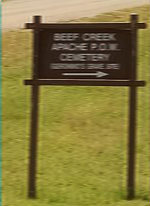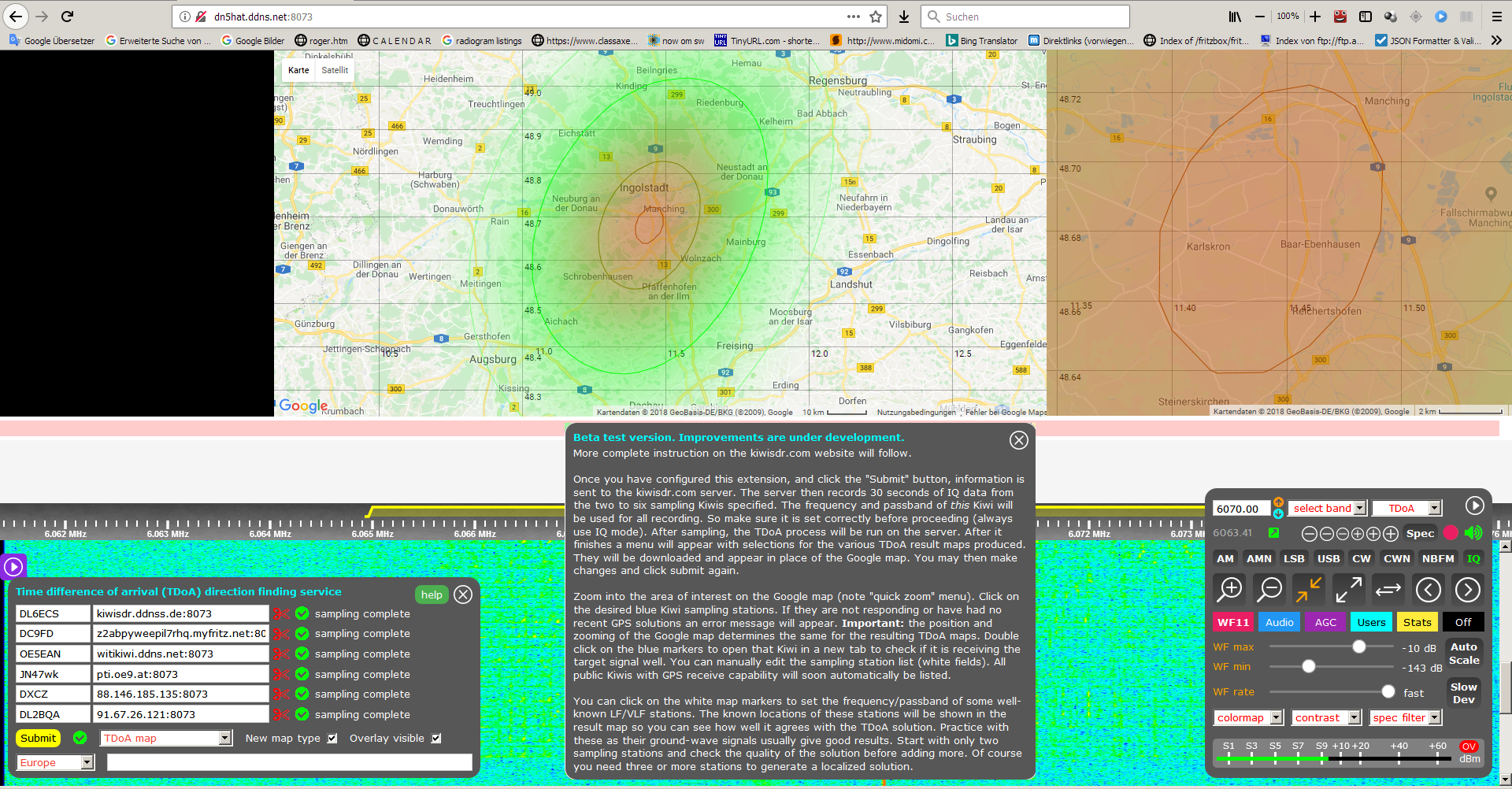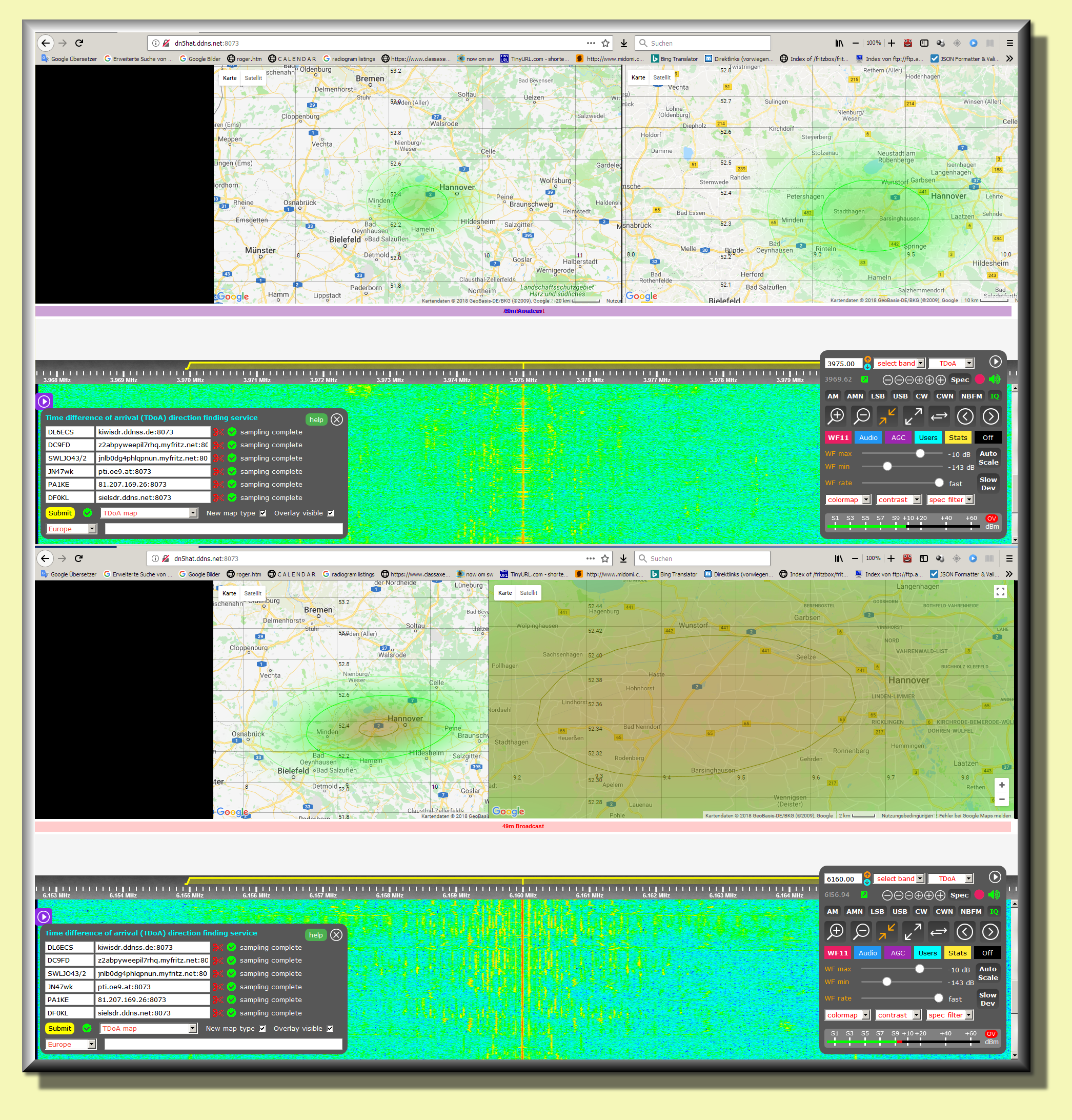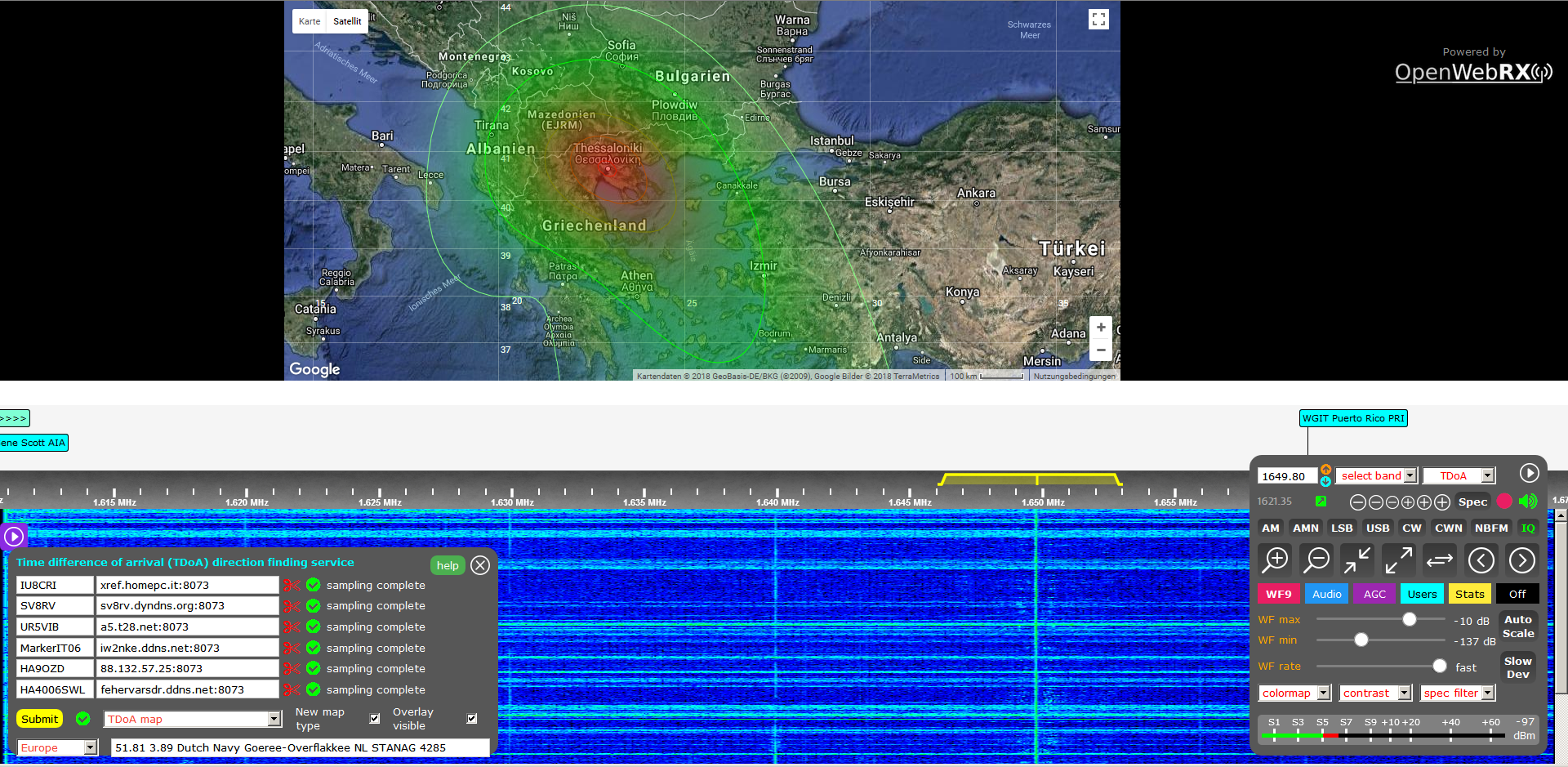http://www.rhci-online.net/radiogram/radiogram.htm
http://www.rhci-online.net/radiogram/radiogram.htm
|
RSID: <<2018-07-11T20:25Z MFSK-32 @ 6070000+1500>>
START IBC - ITALIAN BROADCASTING CORPORATION
mail: ibc@europe.com
|
|

|
|
|

RSID: <<2018-07-13T20:31Z
MFSK-32 @
7780000+1500>>
Welcome to program 56 of Shortwave Radiogram.
I'm Kim Andrew Elliott in Arlington, Virginia, USA
Here is the lineup for today's program, in MFSK modes as noted:
1:34 MFSK32: Program preview (now)
2:47 Climate change causing extreme weather*
8:10 MFSK64: Spiders use electric fields to take flight*
13:18 Young stars visible in new infrared image*
16:26 Ham-designed gear used in Thailand cave rescue*
20:05 Images of the week*
26:15 MFSK32: Closing announcements
* with image(s)
Please send reception reports to
radiogram@verizon.net
And visit http://swradiogram.net
Twitter:
@SWRadiogram
VOA NEWS
Meteorological Organization: Climate Change Causing Extreme
Weather
Lisa Schlein
11 July 2018
GENEVA - The World Meteorological Organization warns the floods,
heatwaves and other extreme weather conditions gripping many
parts of the world are likely to continue as a consequence of
accelerating climate change.
While the world was fixated on the dramatic rescue from a cave in
Thailand of 12 boys and their soccer coach, potentially deadly
monsoon rains were gathering steam in the region.
The World Meteorological Organization reports extreme weather
conditions have dealt a deadly blow in many places, with
blistering heatwaves and disastrous precipitation forecast to
continue this month.
For example, it notes the recent catastrophic flooding in Japan,
the worst in decades, has claimed at least 150 lives. WMO
spokeswoman, Claire Nullis, says the death toll is likely to
climb. This, in what she calls one of the world's best prepared
countries when it comes to tackling disasters.
"They are supremely well prepared," said Nullis. "And, so the
magnitude of the casualties, of the destruction that we are
seeing now really is an indication of just how big and how
extreme this was and how heavy the rainfall was in such a short
period of time."
Other extreme weather events include drought and abnormally high
temperatures in Northern Europe. The WMO expects these conditions
to prevail over the coming weeks.
The WMO reports the United States has had the hottest June on
record. Nullis notes the Los Angeles area in California continues
to hit record high temperatures, such as 48.9 degrees Celsius in
the city of Chino.
Elsewhere in the world, she says a city in the Algerian Sahara
Desert has reported temperatures of 51.3 degrees Celsius.
"Climate change, as we always say, no specific event can be
attributed to climate change, but what we are seeing is
consistent with climate change scenarios," said Nullis. "Extreme
heat, consistent heat, persistent heat and heavy precipitation."
WMO scientists say these extreme weather events are compatible
with the general long-term trend of global warming caused by the
emission of man-made greenhouse gases in the atmosphere.
https://www.voanews.com/a/current-extreme-global-weather-conditions-due-to-climate-change-wmo/4477977.html
Image: A passenger train is derailed by heavy flooding in
Karatsi, Saga Prefecture, Japan ...
Sending Pic:247x102C;
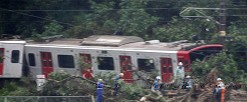
Shortwave Radiogram now changes to MFSK64 ...
RSID: <<2018-07-13T20:38Z
MFSK-64 @
7780000+1500>>
This is Shortwave Radiogram in MFSK64
Please send reception reports to radiogram@verizon.net
VOA NEWS
Research Indicates Spiders Use Electric Fields to Take Flight
Sadie Witkowski
6 July 2018
Since the 1800s, scientists have marveled at how spiders can take
flight using their webbing. Charles Darwin remarked on the
behavior when tiny spiders landed on the HMS Beagle, trailing
lines of silk. He thought the arachnids might be using
heat-generated updrafts to take to the sky, but new research
shows a totally different cause may be at play.
Erica Morley and Daniel Robert from the University of Bristol in
England were interested in exploring a second explanation for the
spiders' ability. They thought spiders might sense and use
electrostatic fields in the air.
"There have been several studies looking at how air movement and
wind can get spiders airborne, but the electrostatic hypothesis
was never tested," Morley told VOA.
Some observers suggested electrostatic fields might be the reason
the multiple draglines some spiders use to float don't get
tangled with each other. Biologist Kimberley Sheldon from the
University of Tennessee at Knoxville, who was not involved in the
new research, pointed out that "though these spiders will have
five or six draglines, those strands of silk do not get
entangled. So we've known for a while that electrostatics
probably [are] at least interacting with the spider, with the
silk lines themselves, to keep them from getting tangled."
Morley and Robert created a box with a grounded metal plate on
the bottom and a plate on the top that they could pass an
electrical current through. The scientists placed spiders in the
box and turned on the voltage, watching as the creatures reacted
to the electric field.
Reaction to current
When the electric field was on, the spiders lifted their abdomens
into the air and started tiptoeing by raising up on the very ends
of their legs. Morley told VOA that spiders only tiptoe right
before they release silk draglines to fly away, in a process
called ballooning.
And when the spiders did balloon and rise into the air, turning
dÕ6he electric current caused them to drop.
Sheldon compared it to taking a balloon and rubbing it against
your clothing. "If you hold the balloon [near your head], your
hair stands on end. That's kind of what's happening with the
spider silk."
Clearly the spiders were able to sense the local electrostatic
field and respond appropriately by releasing silk, but Morley and
Robert wanted to know how.
"As a sensory biologist, I was keen to understand what sensory
system they might use to detect electric fields," said Morley.
"We know that they have very sensitive hairs that are displaced
by air movements or even sound. So I thought that it's possible
that they might be using these same hairs to detect electric
fields."
This was exactly what she observed. The small hairs along the
spiders' legs react not only to physical experiences like a
breeze but also to the electric field. In nature, it makes sense
for spiders to sense both the electrostatic field around them as
well as wind conditions. Spiders probably use both when taking
off and navigating the skies.
Mathematician Longhua Zhao from Case Western Reserve University
in Cleveland has made computer models of how spiders balloon. She
told VOA, "I think that both the electrical field and the fluid
mechanics [of air flow] are important. They definitely play very
important roles. However, we don't know at this point which is
the dominant factor."
Lead researcher Morley pointed out that spiders aren't the only
invertebrates to balloon. "Caterpillars and spider mites, which
are arachnids but not spiders, balloon as well." Morley hopes to
see others follow up her research to see if these other animals
respond in a way similar to the spiders.
The study is published in Current Biology.
https://www.voanews.com/a/spiders-take-flight-using-electric-fields/4471097.html
See also:
http://www.bristol.ac.uk/news/2018/july/spiders-electric-fields-.html
Image: Ballooning spider showing a tiptoe stance on a daisy ...
Sending Pic:225x150C;
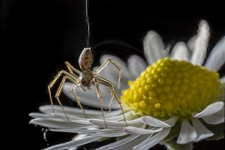
This is Shortwave Radiogram.
Please send reception reports to radiogram@verizon.net
From Science News:
Star "nursery" shines in a stunning new infrared image
Lisa Grossman
11 July 2018
New tech is revealing how young stars have an outsized influence
on their environment. In this image from the Very Large Telescope
in Chile, hundreds of newborn stars sculpt and illuminate gas and
dust in their stellar nursery.
Released July 11 by the European Southern Observatory, the image
shows star cluster RCW 38, which is located about 5,500
light-years from Earth toward the constellation Vela, in infrared
light. Bright young stars shine in blue, while streams of cooler
dust glow in darker red and orange. The stars are so bright and
hot that their radiation pushes the dust and gas around them into
intricate lacelike webs.
Previous pictures of this cluster taken in visible light were far
less detailed, as the dust and gas blocked the stars' light. But
longer-wavelength infrared light can shine through the fog.
This image was taken while astronomers were testing a new
observation system on the Chilean telescope, including an
infrared imager called HAWK-I and a method to reduce blurriness
called GRAAL. GRAAL projects four lasers onto the sky to act as
artificial stars, letting astronomers focus on a "star" of known
brightness and subtract the fuzziness of Earth's atmosphere. That
adjustment lets astronomers bring the real star cluster into
sharper focus.
https://www.sciencenews.org/article/see-star-nursery-shine-stunning-new-infrared-image
Image: This image from the Very Large Telescope, taken while
testing a new infrared telescope, shows infant stars (blue dots)
surrounded by dust (red and orange) in star cluster RCW 38 ...
Sending Pic:241x129C;

This is Shortwave Radiogram.
Please send reception reports to radiogram@verizon.net
From Hackaday:
Ham-designed Gear Used in Thailand Cave Rescue
Al Williams
11 July 2018
Unless you live in a cave, you've probably heard a little about
the thirteen people - mostly children - trapped in the Tham Luang
Nang Non cave in Thailand. What you may have missed, though, is
the hacker/ham radio connection. The British Cave Rescue Council
(BCRC) was asked for their expert help. [Rick Stanton], [John
Volanthen] and [Rob Harper] answered the call. They were equipped
with HeyPhones. The HeyPhone is a 17-year-old design from [John
Hey, G3TDZ]. Sadly, [G3TDZ] is now a silent key (ham radio
parlance for deceased) so he didn't get to see his design play a
role in this high-profile rescue, although it has apparently been
a part of many others in the past.
The HeyPhone is actually considered obsolete but is still in
service with some teams. The radio uses USB (upper sideband, not
universal serial bus) at 87 kHz. The low frequency can penetrate
deep into the ground using either induction loop antennas like
the older Molephone, or - more commonly - with electrodes
injecting RF energy directly into the ground.
You can find a very detailed article about the radio from 2001 if
you want more details --
https://bit.ly/2JikD5a. The system is
somewhat dated, but apparently works well and that's what counts.
What we find interesting is that in today's world, people take
wireless communications for granted and don't realize that cell
phones don't work underground or in the face of widespread
disasters. We would imagine most Hackaday readers know how cell
phone towers use "cellular reuse" to support more than a handful
of phones. Ask some non-technical friend if they know how a cell
phone works and you'll be surprised how few people understand
this. Ham radio operators and hackers are vital to building and
deploying specialized radio systems in times of disaster or - in
this case - where people need rescuing from an odd environment.
We were glad to see a nod to some hacker gear in the popular
press. But we almost wish there had been more reporting on the
volunteer divers and their hacked radio gear.
https://hackaday.com/2018/07/11/ham-designed-gear-used-in-thailand-cave-rescue/
Image: A HeyPhone ready for deployment ...
Sending Pic:219x150C;
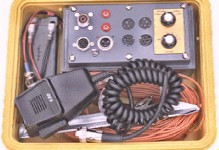
This is Shortwave Radiogram
Please send reception reports to radiogram@verizon.net
IMAGES OF THE WEEK
Sunflowers at sunset at Poolesville, Maryland. From https://bit.ly/2mbThEA ...
Sending Pic:220x155C;

A lotus flower with bees at the Kenilworth Aquatic Gardens in
Washington DC. From
https://wapo.st/2zv4F86 ...
Sending Pic:222x155C;

Our painting of the week is by Kathleen Shaver. From
https://bit.ly/2mcDvta ...
Sending Pic:160x221C;

Shortwave Radiogram returns to MFSK32 ...
RSID: <<2018-07-13T20:56Z
MFSK-32 @
7780000+1500>>
This is Shortwave Radiogram in MFSK32 ...
Transmission of Shortwave Radiogram is provided by:
WRMI, Radio Miami International, http://wrmi.net
and
Space Line, Bulgaria, http://spaceline.bg
Please send reception reports to
radiogram@verizon.net
And visit http://swradiogram.net
Twitter:
@SWRadiogram
I'm Kim Elliott. Please join us for the next Shortwave
Radiogram.
|
Ending song:
https://www.midomi.com/index.php?action=main.track&track_id=100196994922589511&from=voice_search Alexander Gibson - Hebrides Overture, Op. 26, "Fingal's Cave" https://en.wikipedia.org/wiki/Fingal's_Cave
|
http://www.rhci-online.net/radiogram/radiogram.htm
|
QTH: |
D-06193 Petersberg (Germany/Germania) |
|
|
Ant.: |
Dipol for 40m-Band & Boomerang Antenna 11m-Band |
|
|
RX for RF: |
FRG-100B + IF-mixer & ICOM IC-R75 + IF-mixer |
|
|
Software IF: |
con STUDIO1 - Software italiano per SDR [S-AM-USB/LSB] + HDSDR 2.76 stable [2017-02-02] - for scheduled IF-recording |
|
|
Software AF: |
Fldigi-4.00.12 + flmsg-4.0.3 images-fldigifiles on homedrive.lnk |
|
|
OS: |
German XP-SP3 with support for asian languages |
German W7 32bit + 64bit |
|
PC: |
MEDION Titanium 8008 (since 2003) [ P4 - 2,6 GHz] |
MSI-CR70-2MP345W7 (since2014) [i5 -P3560 ( 2 x 2,6GHz) ] |

RSID: <<2018-07-
16T07:30Z MFSK-32 @ 7730000+1585>>
Welcome to BSR Radiogram #14, a
production of James M. Branum (KG5JST) and BroadSpectrumRadio.com.
Life has been crazy busy lately, leaving little time for my little radio
project, so this week I'm only sharing some pictures for the BSR Radiogram, all
from a recent trip I took to Fort Sill, Oklahoma for work (FYI, I am a
civilian attorney who represents US servicemembers in courts-martial,
administrative board hearings, conscientious objector hearings, etc.). While on
post, I decided to drive out to one of the more rural areas of the
military installation to visit the Apache POW (prisoner of war) cemeteries where
Geronomio and many of his kinfolks are buried. Being there was an emotional
thing, a reminder of the heavy cost born by so many, in so many
parts of the world, by the ugly imperialist history of the United States. I have
several pictures I'll be sharing from the cemetery and one of Geronomio himself.
After visiting the cemetery, I drove north, off the post and into the beautiful
and scenic Wichita Mountains National Wildlife Refuge, home of herds of free
range buffalo, elk, longhorn cattle, etc. I didn't have a lot of
time to sight see, but I did drive up the spiral road to the summit of Mount
Scott to take some pictures. I have 2 pictures of the mountain itself and one of
me from the summit.
One last thing... since this Radiogram is shorter than usual, I'll be playing it
two times in a row, so if you missed the first 15 minutes, keep your recorder
and/or FLDGI software going as it will repeat.
As always your QSL reports are always welcome at
broadspectrumradio@gmail.com.
Hopefuly next week I'll be able to do another mailbag show for all of the
detailed QSL reports I've been receiving.
73, James (KG5JST)
Sending Pic:300x419p4;
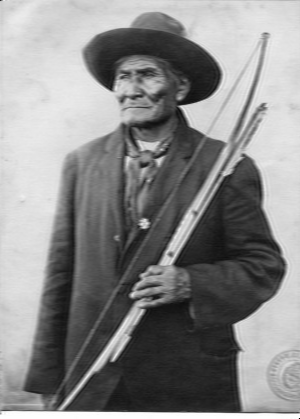
Sending Pic:300x244Cp4;

Sending Pic:300x225Cp4;
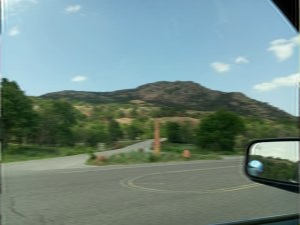
Sending Pic:200x119Cp4;

Sending Pic:300x186Cp4;
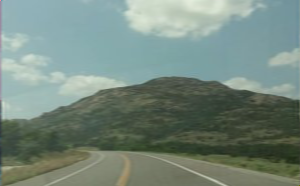
Sending Pic:500x321p4;

Sending Pic:481x290p4;

Sending Pic:150x206Cp4;
